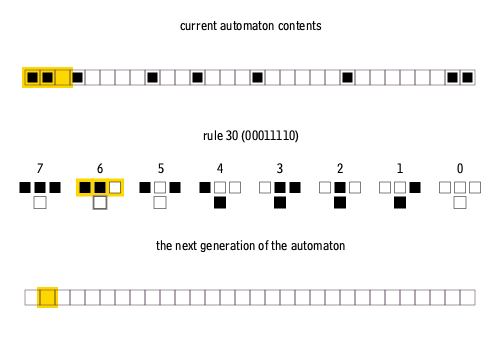|
Elementary Cellular Automaton
In mathematics and computability theory, an elementary cellular automaton is a one-dimensional cellular automaton where there are two possible states (labeled 0 and 1) and the rule to determine the state of a cell in the next generation depends only on the current state of the cell and its two immediate neighbors. There is an elementary cellular automaton (rule 110, defined below) which is capable of universal computation, and as such it is one of the simplest possible models of computation. The numbering system There are 8 = 23 possible configurations for a cell and its two immediate neighbors. The rule defining the cellular automaton must specify the resulting state for each of these possibilities so there are 256 = 223 possible elementary cellular automata. Stephen Wolfram proposed a scheme, known as the Wolfram code, to assign each rule a number from 0 to 255 which has become standard. Each possible current configuration is written in order, 111, 110, ..., 001, 000, and the re ... [...More Info...] [...Related Items...] OR: [Wikipedia] [Google] [Baidu] |
Rule 110
The Rule 110 cellular automaton (often called simply Rule 110) is an elementary cellular automaton with interesting behavior on the boundary between stability and chaos. In this respect, it is similar to Conway's Game of Life. Like Life, Rule 110 with a particular repeating background pattern is known to be Turing complete. This implies that, in principle, any calculation or computer program can be simulated using this automaton. Definition In an elementary cellular automaton, a one-dimensional pattern of 0s and 1s evolves according to a simple set of rules. Whether a point in the pattern will be 0 or 1 in the new generation depends on its current value, as well as on those of its two neighbors. The Rule 110 automaton has the following set of rules: The name "Rule 110" derives from the fact that this rule can be summarized in the binary sequence 01101110; interpreted as a binary number, this corresponds to the decimal value 110. History In 2004, Matthew Cook published a pr ... [...More Info...] [...Related Items...] OR: [Wikipedia] [Google] [Baidu] |
Rule 90
In the mathematics, mathematical study of cellular automaton, cellular automata, Rule 90 is an elementary cellular automaton based on the exclusive or function. It consists of a one-dimensional array of cells, each of which can hold either a 0 or a 1 value. In each time step all values are simultaneously replaced by the exclusive or of their two neighboring values.. call it "the simplest non-trivial cellular automaton",. and it is described extensively in Stephen Wolfram's 2002 book ''A New Kind of Science''. When started from a single live cell, Rule 90 has a time-space diagram in the form of a Sierpiński triangle. The behavior of any other configuration can be explained as a superposition of copies of this pattern, combined using the exclusive or function. Any configuration with only finitely many nonzero cells becomes a replicator (cellular automaton), replicator that eventually fills the array with copies of itself. When Rule 90 is started from a random initial configuratio ... [...More Info...] [...Related Items...] OR: [Wikipedia] [Google] [Baidu] |
Rule 30
Rule 30 is an elementary cellular automaton introduced by Stephen Wolfram in 1983. Using Wolfram's classification scheme, Rule 30 is a Class III rule, displaying aperiodic, chaotic behaviour. This rule is of particular interest because it produces complex, seemingly random patterns from simple, well-defined rules. Because of this, Wolfram believes that Rule 30, and cellular automata in general, are the key to understanding how simple rules produce complex structures and behaviour in nature. For instance, a pattern resembling Rule 30 appears on the shell of the widespread cone snail species ''Conus textile''. Rule 30 has also been used as a random number generator in Mathematica, and has also been proposed as a possible stream cipher for use in cryptography. Rule 30 is so named because 30 is the smallest Wolfram code which describes its rule set (as described below). The mirror image, complement, and mirror complement of Rule 30 have Wolfram codes 86, 135, and 149, respectivel ... [...More Info...] [...Related Items...] OR: [Wikipedia] [Google] [Baidu] |
Rule 34
Rule 34 is an Internet meme which claims that Internet pornography exists concerning every conceivable topic. The concept is commonly depicted as fan art of normally non-erotic subjects engaging in sexual behavior. It can also include writings, animations, and any other form of media to which the internet provides opportunities for proliferation. History The phrase "Rule 34" was coined from a 2003 webcomic captioned, "Rule #34 There is porn of it. No exceptions." The comic was drawn by TangoStari (Peter Morley-Souter) to depict his shock at seeing ''Calvin and Hobbes'' parody porn. Although the comic faded into obscurity, the caption instantly became popular on the Internet. Since then, the phrase has been adapted into different syntactic versions and has even been used as a verb. On August 20, 2007, the webcomic ''xkcd'' published a comic titled "Rule 34", which involved hypothetical sexual scenarios including homoerotic spelling bees. In 2008, users on the imageboard 4chan ... [...More Info...] [...Related Items...] OR: [Wikipedia] [Google] [Baidu] |
Mersenne Numbers
In mathematics, a Mersenne prime is a prime number that is one less than a power of two. That is, it is a prime number of the form for some integer . They are named after Marin Mersenne, a French Minim friar, who studied them in the early 17th century. If is a composite number then so is . Therefore, an equivalent definition of the Mersenne primes is that they are the prime numbers of the form for some prime . The exponents which give Mersenne primes are 2, 3, 5, 7, 13, 17, 19, 31, ... and the resulting Mersenne primes are 3, 7, 31, 127, 8191, 131071, 524287, 2147483647, ... . Numbers of the form without the primality requirement may be called Mersenne numbers. Sometimes, however, Mersenne numbers are defined to have the additional requirement that be prime. The smallest composite Mersenne number with prime exponent ''n'' is . Mersenne primes were studied in antiquity because of their close connection to perfect numbers: the Euclid–Euler theorem a ... [...More Info...] [...Related Items...] OR: [Wikipedia] [Google] [Baidu] |
Universal Computation
A Turing machine is a mathematical model of computation describing an abstract machine that manipulates symbols on a strip of tape according to a table of rules. Despite the model's simplicity, it is capable of implementing any computer algorithm. The machine operates on an infinite memory tape divided into discrete cells, each of which can hold a single symbol drawn from a finite set of symbols called the alphabet of the machine. It has a "head" that, at any point in the machine's operation, is positioned over one of these cells, and a "state" selected from a finite set of states. At each step of its operation, the head reads the symbol in its cell. Then, based on the symbol and the machine's own present state, the machine writes a symbol into the same cell, and moves the head one step to the left or the right, or halts the computation. The choice of which replacement symbol to write and which direction to move is based on a finite table that specifies what to do for each comb ... [...More Info...] [...Related Items...] OR: [Wikipedia] [Google] [Baidu] |
Turing Complete
Alan Mathison Turing (; 23 June 1912 – 7 June 1954) was an English mathematician, computer scientist, logician, cryptanalyst, philosopher, and theoretical biologist. Turing was highly influential in the development of theoretical computer science, providing a formalisation of the concepts of algorithm and computation with the Turing machine, which can be considered a model of a general-purpose computer. He is widely considered to be the father of theoretical computer science and artificial intelligence. Born in Maida Vale, London, Turing was raised in southern England. He graduated at King's College, Cambridge, with a degree in mathematics. Whilst he was a fellow at Cambridge, he published a proof demonstrating that some purely mathematical yes–no questions can never be answered by computation and defined a Turing machine, and went on to prove that the halting problem for Turing machines is undecidable. In 1938, he obtained his PhD from the Department of Mathemati ... [...More Info...] [...Related Items...] OR: [Wikipedia] [Google] [Baidu] |
Pascal's Triangle
In mathematics, Pascal's triangle is a triangular array of the binomial coefficients that arises in probability theory, combinatorics, and algebra. In much of the Western world, it is named after the French mathematician Blaise Pascal, although other mathematicians studied it centuries before him in India, Persia, China, Germany, and Italy. The rows of Pascal's triangle are conventionally enumerated starting with row n = 0 at the top (the 0th row). The entries in each row are numbered from the left beginning with k = 0 and are usually staggered relative to the numbers in the adjacent rows. The triangle may be constructed in the following manner: In row 0 (the topmost row), there is a unique nonzero entry 1. Each entry of each subsequent row is constructed by adding the number above and to the left with the number above and to the right, treating blank entries as 0. For example, the initial number of row 1 (or any other row) is 1 (the sum of 0 and 1), whereas the numbers 1 and 3 in ... [...More Info...] [...Related Items...] OR: [Wikipedia] [Google] [Baidu] |
Mathematics
Mathematics is an area of knowledge that includes the topics of numbers, formulas and related structures, shapes and the spaces in which they are contained, and quantities and their changes. These topics are represented in modern mathematics with the major subdisciplines of number theory, algebra, geometry, and analysis, respectively. There is no general consensus among mathematicians about a common definition for their academic discipline. Most mathematical activity involves the discovery of properties of abstract objects and the use of pure reason to prove them. These objects consist of either abstractions from nature orin modern mathematicsentities that are stipulated to have certain properties, called axioms. A ''proof'' consists of a succession of applications of deductive rules to already established results. These results include previously proved theorems, axioms, andin case of abstraction from naturesome basic properties that are considered true starting points of ... [...More Info...] [...Related Items...] OR: [Wikipedia] [Google] [Baidu] |
Jacobsthal Numbers
In mathematics, the Jacobsthal numbers are an integer sequence named after the German mathematician Ernst Jacobsthal. Like the related Fibonacci numbers, they are a specific type of Lucas sequence U_n(P,Q) for which ''P'' = 1, and ''Q'' = −2—and are defined by a similar recurrence relation: in simple terms, the sequence starts with 0 and 1, then each following number is found by adding the number before it to twice the number before that. The first Jacobsthal numbers are: : 0, 1, 1, 3, 5, 11, 21, 43, 85, 171, 341, 683, 1365, 2731, 5461, 10923, 21845, 43691, 87381, 174763, 349525, … A Jacobsthal prime is a Jacobsthal number that is also prime. The first Jacobsthal primes are: :3, 5, 11, 43, 683, 2731, 43691, 174763, 2796203, 715827883, 2932031007403, 768614336404564651, 201487636602438195784363, 845100400152152934331135470251, 56713727820156410577229101238628035243, … Jacobsthal numbers Jacobsthal numbers are defined by the recurrence ... [...More Info...] [...Related Items...] OR: [Wikipedia] [Google] [Baidu] |






